Is any user data sent across the out-of-band (OOB) connection of a Steelhead appliance?
What happens to traffic when a Steelhead appliance reports admission control?
The Steelhead Mobile client on your laptop is showing a status of “Firewalled”. What is the problem?
What are the possible ways to downgrade a Virtual Steelhead appliance after it has been upgraded?
What type of reporting information will an Interceptor appliance store? (Select 2)
On the Steelhead Mobile Controller, what VPNs require the use of Reorder Intermediate Drivers? (Select 2)
When upgrading a Virtual Steelhead appliance, what steps can be taken to preserve the existing datastore?
What ports are required for proper operation of the Steelhead Mobile client?
The Interceptor appliance will attempt to redirect a connection to a Steelhead appliance in the auto pool:
One of the Steelhead appliances in your Steelhead appliance cluster is running an older version of RiOS. You decide to schedule a change window to upgrade that Steelhead appliance's image to the current release. What should you do to ensure that the Steelhead appliance optimization still occurs and the upgraded Steelhead appliance no longer accepts new connections?
What type of configuration must be used on a Steelhead appliance in order to communicate with an Interceptor appliance?
On the Interceptor appliance, what are the possible filter settings on a load balancing rule? (Select 4)
How can you provide updates to multiple Steelhead Mobile clients at the same time? (Select 2)
In creating a customized Steelhead Mobile client MSI package, what is the Group ID (GID) used for?
What is the command to verify a configuration of the Interceptor peers and peer neighbors?
In order to reset the admin password that has been lost, the procedure can be done via what type of connection to a Steelhead appliance?
RiOS v7.0 and later the Steelhead Appliance can use HTTP stream splitting to optimize two different live video technologies: (Select 2)
What action is taken by the Interceptor if a connection does not match a configured load balance rule and the default pool is empty?
The Primary interface is REQUIRED for which deployment methods and features?
1) In-path
2) Server-side out-of-path
3) Logical in-path (WCCP/PBR)
4) Hybrid Mode
5) Proxy File Services (PFS)
Which of the following commands followed by “write memory” will allow you to turn off in-path optimization but turn it back on upon rebooting the Steelhead appliance?
When deploying policy-based routing for multiple Steelhead appliances in a cluster, the router should be configured to: (Select 2)
Refer to the exhibit.
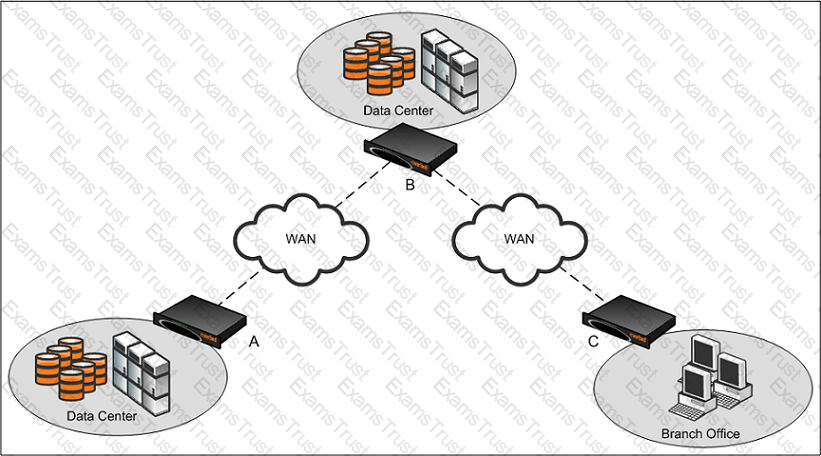
In order to achieve optimization using auto-discovery for traffic coming from site C and destined to site A in the exhibit, which configuration below would be required?
The fair peering feature on Interceptor appliances can be enabled:
Refer to the exhibit.
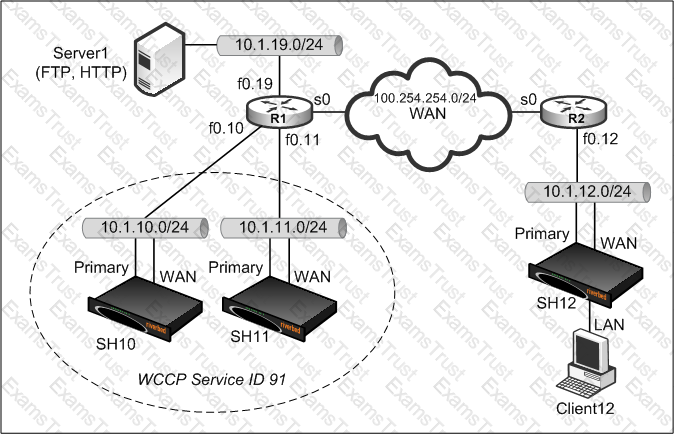
Assume that a packet being optimized by SH10 incorrectly ends up on SH11 (due to load balancing error, or similar). How can you ensure that this packet is correctly returned to SH10?
The adaptive data streamlining settings are:
RiOS v7.0 and later, the packet-mode-optimization feature can: (Select 2)
What is the process for dropping the connection of an individual user that is currently being optimized? As an example, consider an HTTP connection being optimized with a local address of 192.168.5.10 and remote address of 192.168.5.90. (Select 2)
What is the default Connection Forwarding keep alive interval?
How do you clear the peer affinity information from an Interceptor?
Hybrid Mode can best be defined as a combination of:
You are troubleshooting a new Steelhead Mobile installation where none of the VPN users with Steelhead Mobile client installed are being optimized. You determine that the Steelhead appliance in the data center is not in-path for VPN users. What are your options to fix this? (Select 2)
You need to perform a tcpdump of traffic entering the Steelhead appliance's lan0_0 interface. Which of the following demonstrate the proper command format to perform the tcpdump and capture to a file?
Which two of the following attributes are required to be added to a TACACS+ server to enable monitor and admin logon access to the CMC appliance via TACACS: (Select 2)
What are the default port labels on an Interceptor appliance?
What interface on the CMC appliance is required for the initial configuration?
What methods can the CMC appliance use to provide notification of CMC system events? (Select 3)
Which section of the Steelhead appliance Management Console can help identify speed/duplex errors? (Select 2)
The Home page in the Management Console for the CMC appliance can be configured to display what information?
A customer is reporting higher than normal CPU utilization on certain routers in their network. Looking at their Steelhead appliance logs, they see “intercept/localkernel/icore.c:1463] nat_check: SYN packet for already NAT'd connection 100.100.100.33:1611 -> 100.200.200.32:80 ==> 100.201.201.25:7801”. All connections are showing up optimized but the logs persist. Given the exhibit,

what is the likely problem?
An unwanted Steelhead appliance appears on the current connections list of one of your Steelhead appliances. How can you stop inbound connections from this unknown appliance from optimizing with your Steelhead appliances?
You have an existing Steelhead appliance deployment which is achieving excellent optimization at five sites. You have deployed a Steelhead appliance physically in-path at a new small branch office and all of your applications have become slower for this new branch office only. What is the likely cause?
Which are true about the Steelhead appliance backups taken and stored by the CMC appliance? (Select 3)
Which of the following are valid WCCPv2 control messages? (Select 3)
Refer to the exhibit.
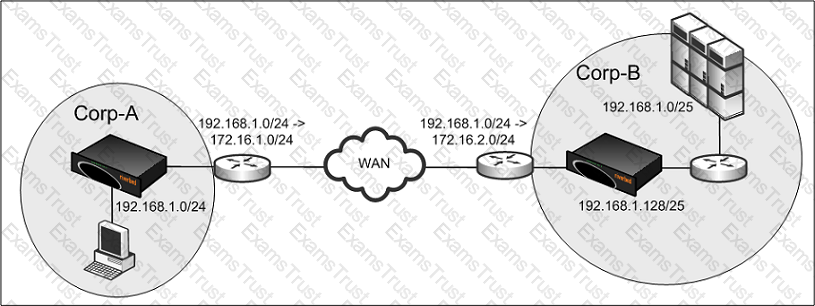
Corp-A and Corp-B have overlapping address space and therefore the network administrator implemented NAT to overcome this. Users from Corp-A NAT to 172.16.1.0/24 and users from Corp-B NAT to 172.16.2.0/24. Users in Corp-A use the destination address of 172.16.2.0/24 to access the resources in Corp-B. The servers in Corp-B use the client IP for authentication. You deploy the Steelhead appliance using the default WAN visibility mode but noticed all the connections are passed-through. What is the likely problem?
Your Steelhead appliance deployment includes users accessing the Internet from branch offices with the traffic being back-hauled to the data center before going out to the Internet. However, HTTP latency optimization does not appear to be very effective, and in certain cases, is slower than without optimization. What settings might help with this Internet-bound traffic?
-- Exhibit –
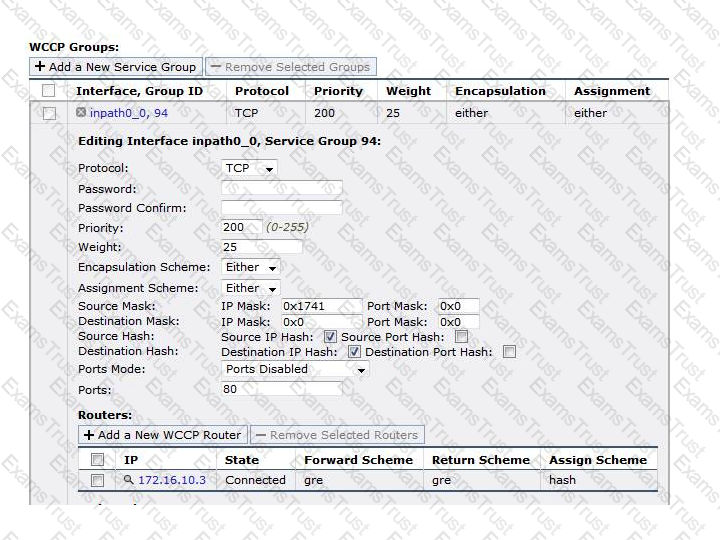
-- Exhibit --
Refer to the exhibit. In a WCCP environment with R3, SH10 and SH11, which statement below is true?
Which deployment options are available to Virtual SteelHead on ESXi?
The picture below corresponds to a connection using the SteelHead SaaS GeoDNS feature. What is the IP address of the closest Microsoft Exchange Client Access Server (CAS)?
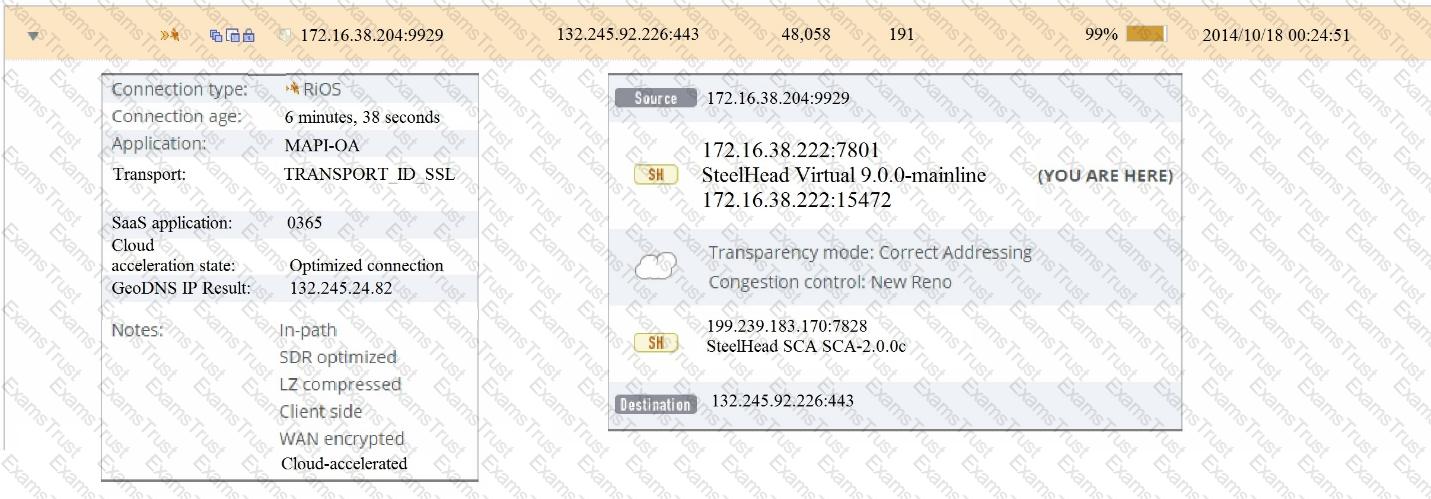
-- Exhibit –
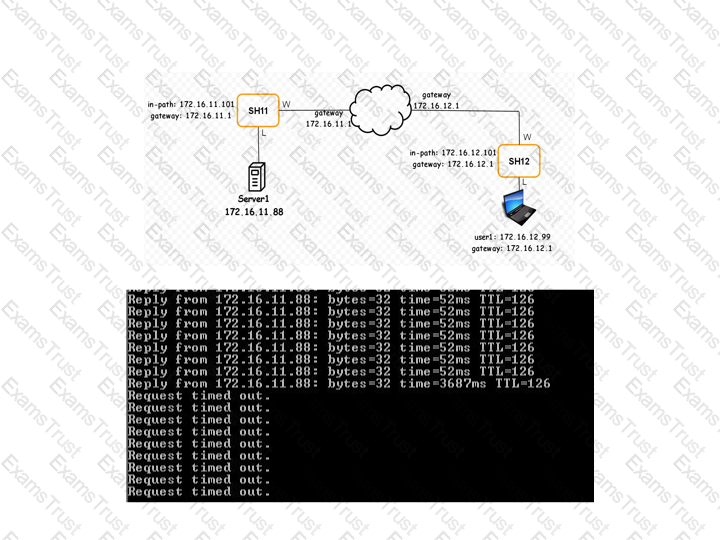
-- Exhibit --
Refer to the exhibit. A Steelhead administrator has recently decided to implement QoS on SH12. The WAN link between Branch1 and the Data Center is a T1. After implement QoS, he started seeing problems with traffic to Server1. What could be the problem and how would you fix it? (Select 2)
Users report that CIFS transfer speeds from a domain member server are much faster than from a domain controller. The Current Connections report confirms that connections to the domain controller show a red warning triangle. What configuration steps are required to resolve this issue?
-- Exhibit –
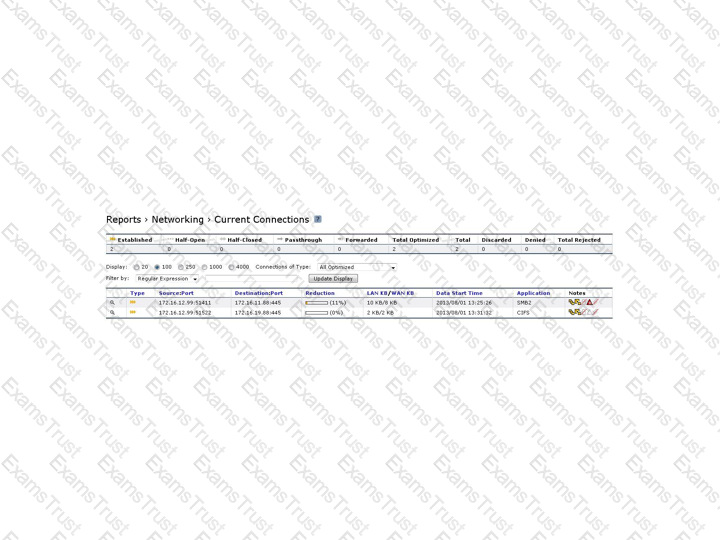
-- Exhibit --
Refer to the exhibit. When USER1 tried to map shares to Server 1 and Server 2, he got the results shown. What does the report represent? (Select 2)
-- Exhibit –
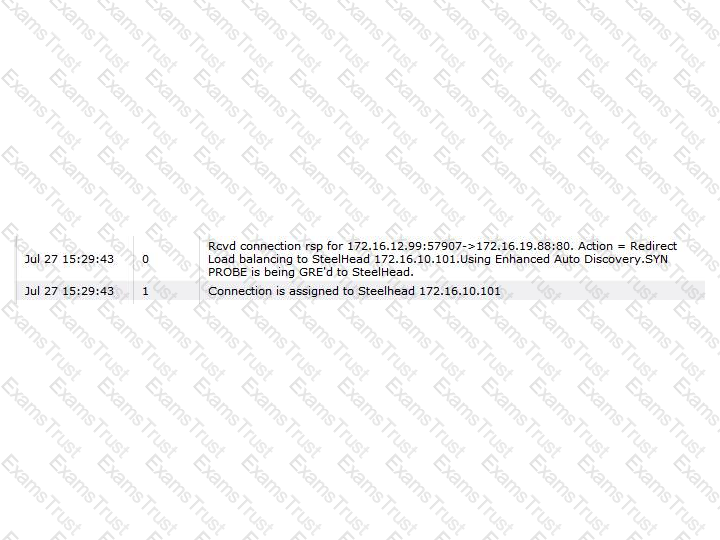
-- Exhibit --
Refer to the exhibit. A Steelhead administrator has decided to implement two Interceptor appliances and one Steelhead appliance on his data center. After configuring the Interceptor appliances, and the Steelhead appliance, he decided to check if the connections are being forwarded appropriately. What happened? (Select 2)
A SteelHead is deployed in a VLAN bridge. Which VLAN ID should be configured on the in-path interface to support this environment?
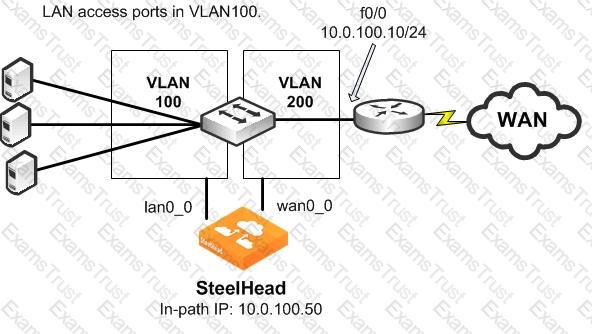
You are using TCPdumps on the server-side SteelHead to troubleshoot an application connectivity issue. The following filter is used on the TCPdump:
(host
and
ip[44:4] =
What part of the filter captures the traffic which the Interceptor has applied NAT to?
Authentication fails for certain users after configuring the Server-Side Steelhead Appliance to be a RODC. What could be the issue?
-- Exhibit –
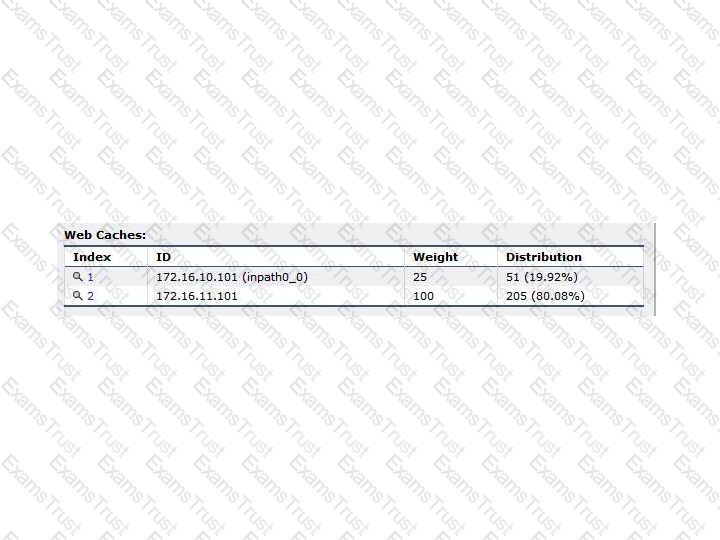
-- Exhibit --
Refer to the exhibit. In a WCCP environment with R3, SH10 and SH11, the following screenshot shows that the load is not being distributed evenly in between the Steelhead appliances. Why?
-- Exhibit –
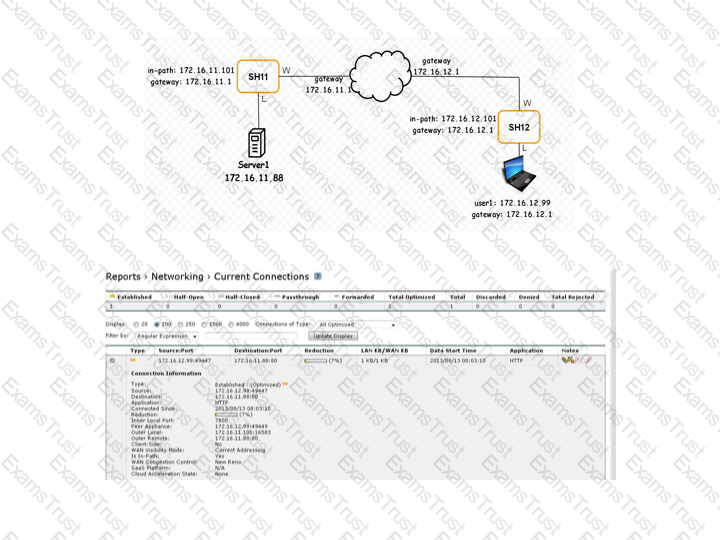
-- Exhibit --
Refer to the exhibit. What statements are true? (Select 2)
Consider a SteelHead deployment with SMB optimization and SMB signing enabled on all SteelHeads. The client is configured to have signing enabled and the server has signing disabled. What will happen to SMB connections between these two hosts?
When using GRE tunneling, you notice an application stops working and you know the application marks packets with the DF (Don’t Fragment) flag.
What is the cause of this?
If data store synchronization is to be successful, which of these must be true?